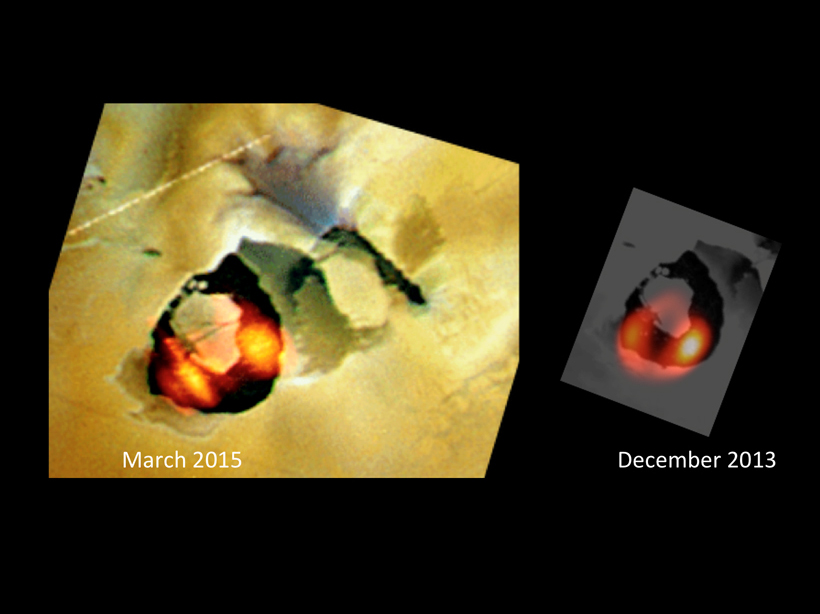The enormous volcano Loki Patera dwarfs anything on Earth yet resides on tiny Jovian moon Io. Astronomers now report taking advantage of a chance alignment—the neighboring moon Europa passing in front of Io, as seen from Earth—to scrutinize the volcano and its huge lava lake with 40 times greater spatial detail than in past observations.
These highest-resolution images of Loki ever recorded from Earth may aid scientists to better answer questions about how this mysterious, 200-kilometer-wide (120-mile-wide) horseshoe-shaped lava feature formed and evolves.
Fortuitous Occultation
Michael Skrutskie, of the University of Virginia in Charlottesville, and his colleagues were already set to examine Loki Patera last March with the Large Binocular Telescope, located in southeast Arizona, when they realized that a chance occultation by Io’s neighbor could dramatically enhance the observations. They then adjusted the timing of their observations to take full advantage of Europa’s temporary interposition.
As astronomers observed the giant volcano Loki (upper bright spot) on the Jovian moon Io (orange disk) earlier this year, Io’s sister moon Europa (dark disk) passed between Io and the terrestrial Large Binocular Telescope. The March 2015 occultation shown in this movie temporarily obscured Io but also made it possible for the telescope to attain a far more detailed view of Loki than it could in the past. Credit: LBTO
During the first part of the occultation, known as the ingress, Europa progressively blocked larger regions of Loki Patera from view. Between successive telescope images, Europa cloaked about 2 additional kilometers of the volcano. The reverse occurred during egress, when Europa receded. By reducing the amount of Loki visible at any moment, Europa’s passage between Earth and Io allowed the telescope to discern finer features of the volcanic terrain than it did in 2013, when Europa’s assist was not available, Skrutskie said.
He described the findings last Thursday at the annual meeting of the American Astronomical Society’s Division for Planetary Sciences in National Harbor, Md.
Shifting Hot Spots
The images reveal that the hot spots within Loki Patera have shifted position since 2013. As Skrutskie and his colleagues analyze more of the data, they may be able to make detailed temperature maps of the volcano, which could test models of how the hot spots develop, study collaborator Ashley Davies of NASA’s Jet Propulsion Laboratory in Pasadena, Calif., told Eos.
In one model, Davies noted, blocks of crust form on the surface of the lava lake created by the volcano. As a block thickens and cools, it becomes less buoyant and finally sinks down to the bottom of the lake. Researchers suggest that these blocks of crust sink successively in a counterclockwise direction around an island in the middle of Loki Patera, taking about 1.5 years to go completely around. The process should generate a systematic temperature distribution across Loki Patera, which may be apparent in the high-resolution data, Davies said.
“Loki Patera is one of the great wonders of the solar system,” and the new observations “may give us the nuts and bolts of how this massive volcano works,” he said.
—Ron Cowen, Freelance Science Journalist; email: [email protected]
Citation: Cowen, R. (2015), Jupiter’s Europa helps earthlings see sister moon’s volcano, Eos, 96, doi:10.1029/2015EO039871. Published on 17 November 2015.
Text © 2015. The authors. CC BY-NC 3.0
Except where otherwise noted, images are subject to copyright. Any reuse without express permission from the copyright owner is prohibited.

